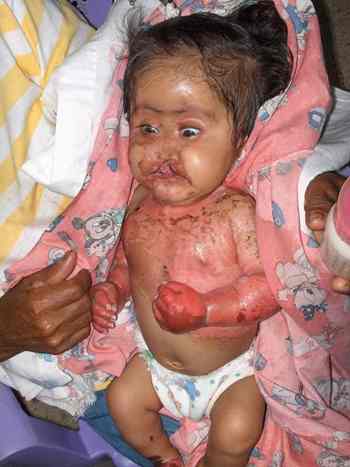semanas (1-12, 22,23) por lo que queda como recomendación instaurar un programa de ultrasonografía prenatal diagnóstico para detección precoz de malformaciones como estas en países de Centro América y así poder brindar un adecuado asesoramiento genético a los padres.
Anexo 1 (Foto de la Paciente)

REFERENCIAS BIBLIOGRÁFICAS
- Trisomía 13. En: Manual Merck. Anomalías Autosómicas. 10 ed., edición del centenario: Elzevir Science; 1999. p 2243.
- Cassidy SB, Allanson JE. Management of Genetics Syndromes. Willeym Liss; 2007.
- Crolla JA. Fish and molecular studies of autosomal supernumerary marker chromosomes excluding those derived from chromosome 15. Review of the literature. Am J Med Gent. 2008; 75(3):p367 – 81.
- Wald N, Leck I.Antenatal & Neonatal Screening.2nd ed. Oxford: Oxford University Press; 2007
- Vacher Borbolla. Genética Médica. En: Pediatría 4. Habana: Pueblo y educación; 1997. p 141-177.
- Gurrieri, F. Physical mapping of the holoprosencefhaly critical region on chromosome 7q36. Nat. Genet. 2008; 33(3): p 247.
- Ferrer Casero E. Ciclopía. Informe de un caso. Rev Cubana Obstet-Ginecol. 2007; 10 (3): p353- 359.
- Shaw C. Holoprosencephaly: An Overview and Atlas of Cases. New York, Willeymliss. 2009.
- Smith D.W. Holoprosencefhaly anomalad. In: Recognizable Patterns of Human malformation. Philadephia. W. Saunders Co; 2007.
- Vogel F. The Human genome. Chromosomal aberrations and spontaneous miscarriage in: Human genetics. Berlin: Springer-Verlay. 2007; 46(2): p 76-82.
- Muenke M. Linkaje of a human brain malformation, familial holoprosencephaly, to chromosome 7 and evidence for genetic heterogeneity. Proc Natl, Acad. Sci. U.S.A. 2007 91(3): p 8102.
- Lehman C. Trisomy 13 Syndrome: prenatal us findings in a review of 33 cases. Radiology 2007; 194 (4): p 217-222.
- Snidjers R. Ultrasound markes for fetal Chromosomal defects. The Parthenson publishing group. London.2008.
- Roessler E. Cytogenetic rearrangements involving the loss of the sonic hedgehog gene al 7q36 cause holoprosencefhaly. Hum Genet. 2008; 100 (2): p 172-181.
- Habif TP. Bacterial infections. In: Clinical Dermatology. 3rd ed. St. Louis: Mosby-Year Book; 2007. p 264.
- Jain A, Daum RS. Staphylococcal infections in children: Part 3. Pediatr Rev.2007; 20 (5): p 261.
- Ladhni S. Clinical, microbial, and biochemical aspects of the exfoliative toxins causing staphylococcal scalded syndrome. Clin Microbiol Rev.2008; 12 (6): p 224.
- Ladhani S. Development and evaluation of detection systems for staphylococcal exfoliative toxin A responsible for scalded-skin syndrome. J Clin Microbiol.2009; 39 (3): p 2050.
- Manders SM. Toxin-mediated streptococcal and staphylococcal disease. J Am Acad Dermatol 2009; 39 (4): p 383.
- Swartz MN. Cellulitis and subcutaneous tissue infections. In: Mandell GL. Principles and Practice of Infectious Diseases. 5th ed. Philadelphia: Churchill Livingstone; 2009. p 1037.
- Stewart C. Skin and soft tissue infection update: Presentation, diagnosis, and syndrome–specific antibiotic management, in emergency medicine reports. Am Health Consultant. 2009; 21(4): p 34_ 37.
- Jones KL. Smith’s Reognizable Patterns of Human Malformation. 5th Edition. WB Saunders, Philadelphia. 2007; 34 (5) p 18-23.
- Benacerraf BR, Miller WA, Frigoletto FD. Sonographic detection of fetuses with trisomies 13 and 18: accuracy and limitation. Am J Obstet Gynecol. 2008; 158 (7): p 404-9.